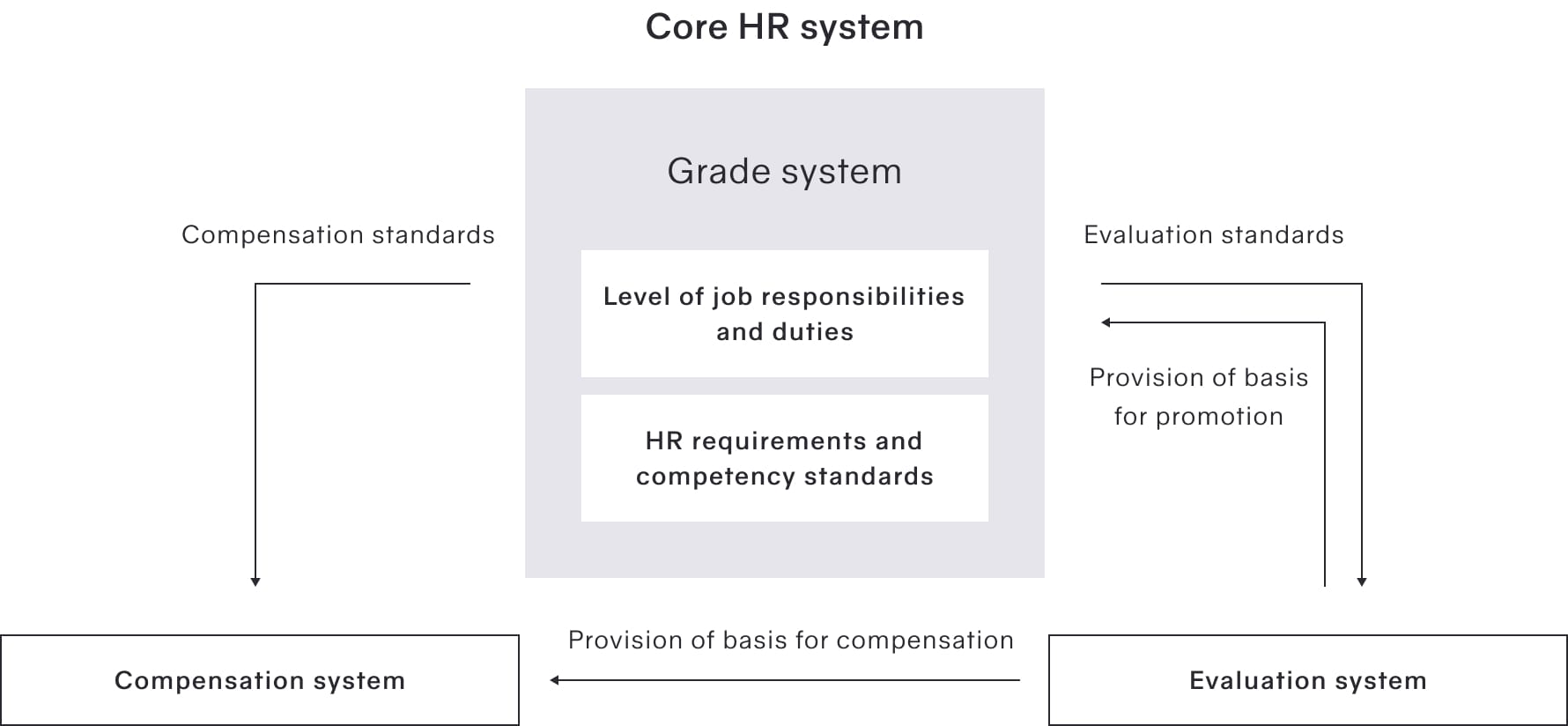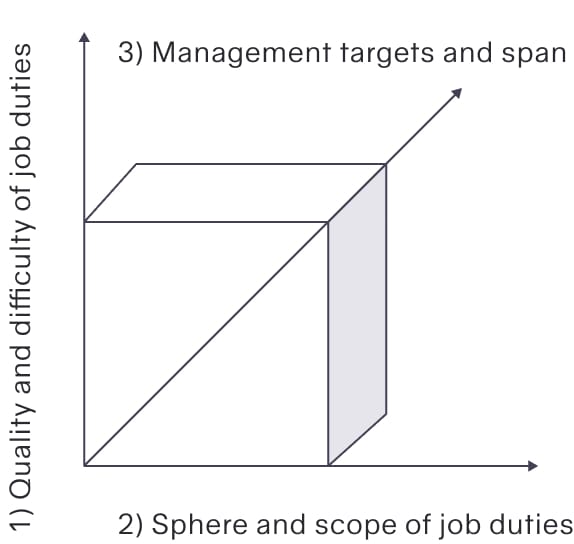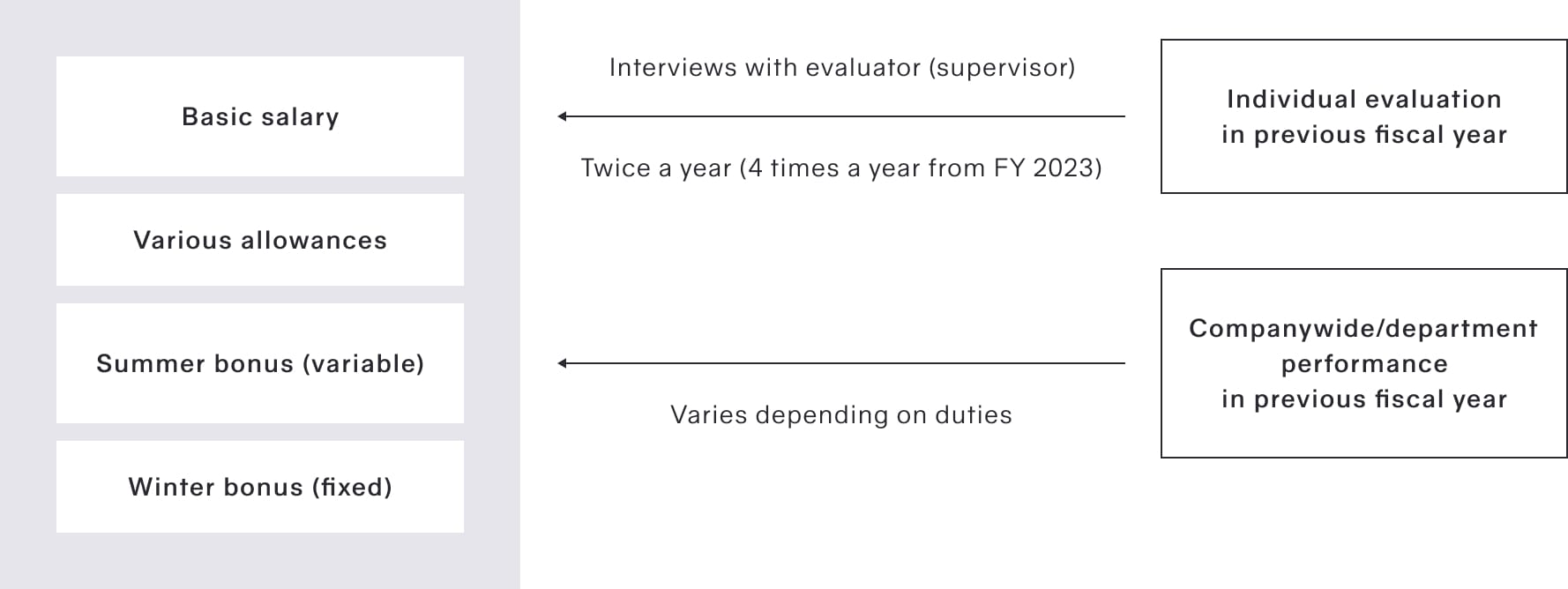Fair Compensation, Benefits and Evaluations Sustainability
Basic Concept
Aiming to maximize human capital is one of our highest-priority management issues. It is important that all employees who work at GOLDWIN firmly understand the roles that they are expected to perform, and that there are means for them to contribute to achieving our organizational goals through execution of their job duties. We have a core HR system for conducting fair evaluations and determining compensation and benefits, and operate it with a high degree of transparency through communication with employees. We also prohibit all forms of discrimination based on the GOLDWIN Group Policy on Human Rights. In our wage system as well, gender-based discrimination is prohibited, with compensation determined in compliance with laws related to equal pay for equal work.
New HR system
We introduced a new HR system in FY 2022. The new HR system is based on the concepts of being a simple and compelling framework for producing human resources to drive business growth as well as to activate and pass down GOLDWIN DNA. As a job-type HR system, it focuses on having the company clearly present to employees what is expected of them, and presenting career paths based on this.
The new HR system comprises three core HR systems. These are the grade system, which defines the job duties, competencies, experience and other attributes expected of each grade, the evaluation system defining the evaluation criteria, and the compensation system that determines compensation from the results of the grade-based evaluation of job performance. As a job-type HR system, the HR system is based on the job duties that make up the assigned work and roles. We define the grades, evaluation criteria and compensation scheme based on the three pillars of 1) quality and difficulty of the job duties, 2) sphere and scope of the job duties, and 3) management targets and span.
Implementing the new HR system allows us to clearly define the roles for job duties and conduct evaluations that earn employee support as well as enable strategic HR rotations and HR development.
Furthermore, rehired employees aged 60 years or older were previously paid a uniform wage, but with the shift to a job-type HR system, they are now evaluated according to their duties. The system complies with equal pay for equal work without any discrimination based on gender or age.
With the introduction of the new HR system in FY 2022, we held online evaluator briefings and feedback interview briefings to ensure a better understanding of the system and to share the evaluation axes. All eligible employees attended, with follow-up also conducted later in an archived session. These evaluator briefings will be held annually. From FY 2023, we will establish a system that backs up the career development of employees by increasing the number of interviews employees have with their supervisors each year from two to four. We will also conduct employee satisfaction surveys to identify any areas of concern in the new system. Improvements will then be made to increase the transparency and acceptability of evaluations, with the aim of achieving stable operation of the new system.

Components of duties

| 1) Quality and difficulty of job duties |
Differences in the quality of outcomes created in the course of work
Difficulty of work
|
|---|---|
| 2) Sphere and scope of job duties |
Spheres (expertise) and scope of work
|
| 3) Management targets and span |
Items that need to be managed in fulfilling job responsibilities and the scope of those items
|
Deciding Fair and Competitive Compensation and Benefits
We prohibit all forms of discrimination based on the Goldwin Group Policy on Human Rights. In our wage system as well, sex-based discrimination is prohibited, with compensation determined in compliance with laws related to equal pay for equal work. Compensation and benefits are determined not only in terms of compliance with legally mandated minimum wages. The trends in labor wages in each region and the wage levels of competitors in the same industry are fully understood, and decisions are made while taking into account our business performance, to provide competitive pay above the level of living wages.

| FY 2018 | FY 2019 | FY 2020 | FY 2021 | FY 2022 | |
|---|---|---|---|---|---|
| Average salary | 6,483,984 | 6,810,469 | 6,072,614 | 6,377,448 | 6,958,261 |
| Regular employees | 7,357,982 | 7,849,157 | 6,513,754 | 6,860,204 | 7,393,948 |
| Contract employees (office workers) | 4,859,125 | 5,342,443 | 5,418,713 | 5,680,879 | 6,484,777 |
| Contract employees (sales associate positions) | 3,966,186 | 4,143,953 | 3,859,979 | 3,916,816 | 4,041,056 |
| FY 2021 | FY 2022 | |
|---|---|---|
| All employees | 62.0% | 65.4% |
| Regular workers (regular employees) | 59.1% | 64.4% |
| Irregular workers (part-time and contract employees) | 73.5% | 75.1% |
Corporate Pension Plan
Our Group operates a corporate pension plan with the aim of ensuring a stable lifestyle for employees after retirement. The plan consists of a defined benefit (DB) pension plan and a defined contribution (DC) pension plan, with monthly contributions being made according to the grade of each employee. With respect to the defined contribution (DC) pension plan, we have adopted a matching contribution plan (employee contributions) up to an amount equivalent to our contribution.
| Number of participants | Contributions in FY 2021 | Number of participants | Contributions in FY 2022 | |
|---|---|---|---|---|
| Defined benefit (DB) pension | 912 | 547,317,540 | 888 | 544,738,080 |
| Defined contribution (DC) pension | 912 | 59,610,243 | 887 | 58,969,843 |
Employee Stock Ownership Plan
GOLDWIN has introduced a stock ownership program for employees (the GOLDWIN Employee Stock Ownership Plan).
The GOLDWIN Employee Stock Ownership Plan was established as part of our welfare program to help employees (regular and contract employees, including at Group companies) build up financial assets over the medium to long term. Employees who participate in the stock ownership plan contribute a certain amount of money (any number of 1,000-yen units from 1 to 50) to the plan by having it deducted from their salaries and bonuses. Boosted by a 10% incentive from GOLDWIN, employees can then purchase GOLDWIN shares without any difficulty. In addition, we expect that a heightened awareness for our company’s management will translate into an improvement in corporate value. When employees want to sell the shares, in accordance with the Insider Trading Regulations, they must complete an Application to Sell Company Stock and obtain approval from the general manager of the General Affairs Department. As of March 2023, 947 employees were participating in the plan.
Future Issues
We will continue to make fair evaluations and decisions on compensation and benefits, while operating with a high degree of transparency through communication with employees. In FY 2022, we introduced a new HR system and focused on transitioning smoothly to the new system and building understanding among employees. From FY 2023 onward, we will conduct employee satisfaction surveys to identify any areas of concern in the new system. Improvements will then be made to increase the transparency and acceptability of evaluations, with the aim of achieving stable operation of the new system. Our aim is to improve productivity through the new system, and together with reforms of each system, we will work to improve employee satisfaction and revitalize the organization.
